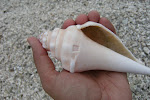You can find a few nudis in the shallow waters of Saipan's beaches. You just have to look carefully since they are very small, and although quite colorful, they are camouflaged well in the marine environment. This is the Elysia ornata I found a few weeks ago in Obyan Beach.
I found a few more this weekend that I would like to share. I do not have an underwater camera and couldn't get a picture of the Thuridilla gracilis that I saw in Obyan last week. I did manage to find another one at Coral Ocean Point.
She was strikingly beautiful and only about 15 millimeters long.
Can you tell how tiny she is from the size of the sand grains in the picture? Tiny!
They are a lot bigger than the T. gracilis, at about 30mm long and 10mm wide. I found a few of them in the shallow reef flat of Wing Beach.
I think they must be pretty common here since I always happen upon them at several shallow beaches. You can check out more nudibranch information and look at beautiful pictures in Nudipixel where a few of my friends have contributed their finds from Guam and Saipan.
I think these maybe are the more common shallow water nudibranchs around here but I will keep an eye out for others. Thanks for talking stories again.
Ti napu.
The Beachcomber





.jpg)







